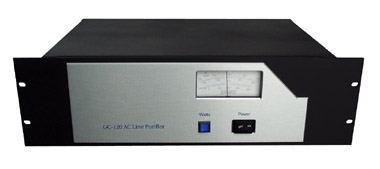Product Review - Smart Theatre Systems
GC120 Balanced Power Supply / AC Line Purifier - November, 2001
Brian Florian
![]()
|
Specifications: Power Output: >1800 Watts 8 Isolated Ground Outlets, GFIC Protected CMR and Noise Reduction: 60 dB 1 Hz - 2 MHz Full Load Loss: <1volt @ 15A Includes 100% Shielded 14 AWG Stranded Line Cord Size: 5.25" H x 19" W x 11" D Weight: 48 Pounds (21.8 kg) MSRP: $1,995 USA
|
| Smart Theatre Systems, 5945 Peachtree Corners East, Norcross, Georgia 30071; Phone (800) 45-SMART or (770) 449-6698; Fax (770) 449-6728; E-Mail [email protected]; Web http://www.smartdev.com. |
Snake Oil or Penicillin?
I am basically a practical realist in the realm of audio/video. I'm into things that work and make sense. Wild looking power cords and funky digital interconnects are not my bag. Yet, AC line conditioners, often considered a grey area, are something I was sitting on the fence about for the longest time. I really wanted to find an original, something that made sense, but all I found were glorified power bars and black boxes of empty promises. Then one of only a handful of people whose opinions on this stuff I trust made a very tangible and real discovery when looking at balanced power: the stability/jitter of a certain digital audio connection was dramatically improved when running on balanced power vs. the wall. Jubilation? Excitation? Not quite, but my interest in the field was refreshed, and I began to check out the effects of balanced AC in my system. The snake oil of yesteryear's power conditioners was being replaced with the penicillin that is balanced power.
Serenity now . . . .
Balance, or Isolation?
When I started writing this review, I began to realize that I had a lot to learn about what balanced AC is and is not. In particular, the term CMR (Common Mode Rejection) is thrown around way to much without due regard to what role it is actually playing and where it is playing.
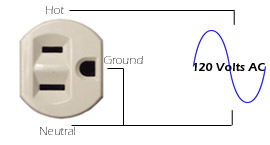 |
| Single Ended (Unbalanced) AC |
A quick refresher: DC power, exemplified by a simple flashlight, flows in one direction. Out one end of the battery (-), through the bulb, and back in the other end (+). AC power on the other hand alternates direction back and forth at a rate of 60 cycles per second. The voltage is rising to +170 Volts, dropping through 0, and hitting a low of -170 Volts. To represent it visually, it looks exactly like a sine wave. Anyone remember trig class? Might have done well to pay attention to the black board instead of the cute girl two rows up. If we had, we'd understand how the RMS (Root Mean Square) of +/-170 is 120 Volts. Hence the North American 120 Volts AC which is in every house on the continent.
But regardless of direction, electrical voltage is always referenced to a ground point. While the 120 Volts exist across the Hot and Neutral of your outlet, it does so because (as you might have guessed from the name) Neutral and Ground are at the same potential, i.e., both are "the zero". In layman's terms, the �120 Volts AC is just as good between neutral and hot as it is between ground and hot. So what's wrong with that? As it turns out, plenty. For one, the electrical wires out on the poles and in your house are antennas, gathering airborne signals like there is no tomorrow. More interesting is that the ground wire gets electrically dirty because non-linear loads create reactive currents that invade our ground and it is no longer really zero. Or in simpler phrase, our appliances and equipment spill currents back onto the power lines which get transferred from the neutral to the ground wire.
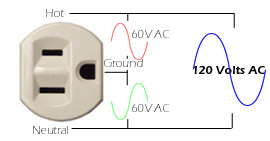 |
| Balanced AC |
Balanced power delivers the same juice, 120 Volts AC, but in two parts. 60 Volts AC is being delivered across ground and neutral, while another 60 Volts AC is being delivered across ground and hot. The key is that these two 60 Volt AC legs are perfectly out of phase with each other. When one is at +60, the other is at -60, delivering a total 120 Volts AC across what was once Hot and Neutral.
So how does that help? It's not so much the balanced AC that help as it is the way it gets made. Power supplies like the GC120 make balanced AC by using a huge isolation transformer and taking a center tap as the "new" ground. The transformer is effectively a band-pass filter pretty much eliminating DC and very low frequency noise as well as some of the high stuff. This leaves only the frequency which the audio/video equipment's own power supplies were designed for and lets them operate more efficiently. The balanced aspect plays out on the "cleaned" side of the transformer where CMR (Common Mode Rejection) applies to noise generated between the GC120 and the equipment connected to it. Reactive currents from the equipment come to ground phase-inverted, and cancel out.
The center tap of the transformer,
when truly centered, allows the ground to sit exactly between the voltage
potentials of
each side of the output, essentially putting the ground in the eye of the hurricane. Its existence assures that currents that would
otherwise have to run through the neutral, which is connected to the ground at
the box, do not transfer voltage potential to the ground, which would
otherwise produce electrical noise.
Because the voltage from each side of the output of the transformer will be
equal and opposite, the center tap, tied to system ground, isn't canceling
out just noise, but the AC voltage swing itself.
Sweet eh? And so simple. It's not the final word in power, but its a HUGE step.
Smart Theater Systems: The Midas Touch
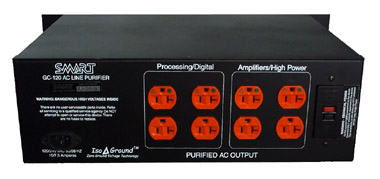 Early this year Smart Theater Systems
impressed us with their 2X150VT
hybrid amplifier. The print ads
promised a true audiophile caliber amplifier, sublime in its design,
construction, and performance. It was our privilege to be the first to
review the unit and confirm the lofty claims. When Oscar Neundorfer
dropped the line that he was working on a balanced AC power supply, requesting
one for review was a matter of course. I expected Oscar to apply the same
Midas touch refinements to an AC power supply which he demonstrated on the
amplifier. I would not
be disappointed. What they have come up with is a double whammy:
It's an AC line purifier/balancer which is both robust and refined, catering to
both commercial
and audio/videophile applications.
Early this year Smart Theater Systems
impressed us with their 2X150VT
hybrid amplifier. The print ads
promised a true audiophile caliber amplifier, sublime in its design,
construction, and performance. It was our privilege to be the first to
review the unit and confirm the lofty claims. When Oscar Neundorfer
dropped the line that he was working on a balanced AC power supply, requesting
one for review was a matter of course. I expected Oscar to apply the same
Midas touch refinements to an AC power supply which he demonstrated on the
amplifier. I would not
be disappointed. What they have come up with is a double whammy:
It's an AC line purifier/balancer which is both robust and refined, catering to
both commercial
and audio/videophile applications.
The GC120 (or "Garbage Collector 120 Volts") is a behemoth. At 48 pounds, it is easily heavier than many power amplifiers and as such is a brute to maneuver. Smart packs them very snugly, and our review sample made the journey to Canada without incident. The build is impressive with a case made from 1.6mm aluminum and with a 4mm face plate. It is rack mountable, and all the connections and fittings are tight and secure.
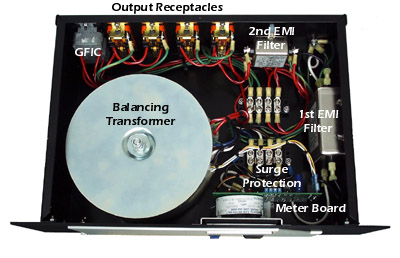 On the back we find an IEC socket for the power
cord, permitting easy replacement with an exotic one should you desire.
In the opinion of this writer (and to a certain extent Smart's opinion as well)
there is little to justify replacing the AC power cord they include which uses 14 AWG stranded conductors and 100% shielding. All a power cord
need do at this stage is deliver maximum current. If you are pushing the
1800 watt capacity of the GC120, you might opt for a cord of 12 AWG caliber.
On the back we find an IEC socket for the power
cord, permitting easy replacement with an exotic one should you desire.
In the opinion of this writer (and to a certain extent Smart's opinion as well)
there is little to justify replacing the AC power cord they include which uses 14 AWG stranded conductors and 100% shielding. All a power cord
need do at this stage is deliver maximum current. If you are pushing the
1800 watt capacity of the GC120, you might opt for a cord of 12 AWG caliber.
The circuit topology is straightforward. The incoming AC goes through the first EMI/RFI filter. This is a boxed LCR low-pass, securely fastened to the chassis. Remember we said the balancing transformer band-passes the power so that the power supplies of our equipment had less mess to deal with? It does a good job, but some of the high frequencies, really high frequencies, slip through, so this first filter "pre-cleans" to a certain extent the power as soon as it gets in the box. The filter is rated for 20 Amp and thus does not limit any current. The power switch comes next.
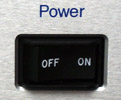 I've seen balanced power supplies go
without a power switch and to a certain extent I agree that one should not be
turning a system on and off at a single point. If you're concerned about
the power bill, don't be. It would cost $10 cnd a year to have the GC120
plugged in doing nothing. But its still not a bad idea to have a power
switch. For one, it's better to have the unit off when making
connections, and when you go on vacation. Some equipment, like my TV, draws a small arc when being
plugged in or out, even if turned off. By first switching off the GC120,
plugging the TV in, and turning the GC120 on, I avoid scoring the contacts.
The switch is also nice to have in case of emergency (dream up your own
scenario). Having said all that, Smart did not want a switch to be any
sort of limiting factor to current and at the same time wanted it to really
switch things off. The GC120 uses a hydraulic/magnetic industrial
circuit breaker as a power switch which cuts both Hot and Neutral lines when turned off.
When on, it virtually fuses the contacts together ensuring maximum power
throughput.
I've seen balanced power supplies go
without a power switch and to a certain extent I agree that one should not be
turning a system on and off at a single point. If you're concerned about
the power bill, don't be. It would cost $10 cnd a year to have the GC120
plugged in doing nothing. But its still not a bad idea to have a power
switch. For one, it's better to have the unit off when making
connections, and when you go on vacation. Some equipment, like my TV, draws a small arc when being
plugged in or out, even if turned off. By first switching off the GC120,
plugging the TV in, and turning the GC120 on, I avoid scoring the contacts.
The switch is also nice to have in case of emergency (dream up your own
scenario). Having said all that, Smart did not want a switch to be any
sort of limiting factor to current and at the same time wanted it to really
switch things off. The GC120 uses a hydraulic/magnetic industrial
circuit breaker as a power switch which cuts both Hot and Neutral lines when turned off.
When on, it virtually fuses the contacts together ensuring maximum power
throughput.
Next comes the surge protection. By far the most common technology for this purpose is MOVs (Metal Oxide Varistors). Used in even the best surge bars, MOVs have a drawback: They weaken with every "hit", eventually offering no protection at all. This is why 'better' surge bars will either die or at very least alert you that protection is no longer available. But while it's easy for a manufacturer to replace a power bar, no one wants to send a 48 pound GC120 back to the factory after a nuisance surge. Smart has broken tradition and used industrial duty TransZorb� avalanche transient surge suppressors. These tiny diode devices are only conductors once their overvoltage threshold is reached, at which point they avalanche and instantly dump the overvoltage directly to ground.
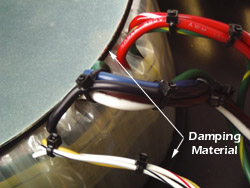 The balancing transformer comes next.
Massive in appearance, it is made by Smart's own Smart Magnetics Division to their own
specifications.
The balancing transformer comes next.
Massive in appearance, it is made by Smart's own Smart Magnetics Division to their own
specifications.
The core gets impregnated with epoxy to fill small air gaps. This, and
the thin (0.23mm/9mils) steel banding used to make the core, are said by Smart to make an
overall quieter transformer. Indeed, even with an ear right on the
chassis, the natural hum is hard to detect. The transformer is set on a
damping pad and is held in place at the top with another pad under the metal
top plate.
Kapton� insulation is used between the primary and secondaries because of its
heat tolerance and fire resistance. This is the same material some
speaker manufacturers
use for voice coil formers. While touring the
Paradigm factory, I had an opportunity to put fire to one of these formers and was
impressed with the material's resistance to flame.
Further separating the windings is a copper Faraday shield, grounded to line
ground. The shield is wrapped in Mylar to block arcs. Safety first: The unit is Hi-Pot tested.
All the above info is for driving home the fact that this is
not an off-the-shelf transformer. Published spec is 1800 Watts continuous;
in reality the design allows over 2000. In fact, the loss at full load
(15A) is quoted at a scant 1 Volt. The transformer actually delivers a
volt or two more than your wall supply at idle so that at full load, it is not
dropping. In practicality though, the power in your house fluctuates
quite a bit. As evidenced by simple readings at an
outlet, my own house sees as little as 114 VAC to as much as 122 VAC in the
course of an evening.
Once the power is through the transformer, it passes through GFIC protection (Ground Fault
Interruption Circuit) which cuts juice if there is a short between either of
the new hot lines and ground. I have to note (as Smart does in the manual), the GFCI will not protect from shorts across
the two hot lines.
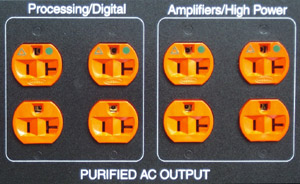 The juice then goes in
two directions. One path feeds the outlets marked "Amplifiers/High
Power"
directly. Along the other path, the power goes through a second, smaller EMI/RFI
filter much like the first, and then on to the outlets marked "Processing/Digital".
The feeling here is that digital sources and other components which use DSP
end up generating noise which would otherwise go to the other components in
the system. There is no current limit to one bank or the other, and Smart
encourages you to experiment with plugging your equipment into the different
banks to get the best results.
The juice then goes in
two directions. One path feeds the outlets marked "Amplifiers/High
Power"
directly. Along the other path, the power goes through a second, smaller EMI/RFI
filter much like the first, and then on to the outlets marked "Processing/Digital".
The feeling here is that digital sources and other components which use DSP
end up generating noise which would otherwise go to the other components in
the system. There is no current limit to one bank or the other, and Smart
encourages you to experiment with plugging your equipment into the different
banks to get the best results.
Hospital Grade Hubbell outlets are used
on all the GC120's outputs. "Hospital Grade" implies they are good
enough for Hospitals (duh!), where you would not particularly want the
dialysis machine to stop working just because the AC outlet had corrosion on
it or a loose grip. What this really means, among other things, is
that the plastic does not give off anything that would affect hypo-allergenic
people, won't succumb to bizarre chemicals, has an isolated ground (separated
from the casing), and will hold on to a plug for dear life (literally).
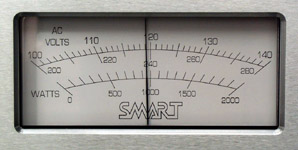 It is
this last characteristic that is of particular interest to audio and videophiles. Try plugging anything in to a Hospital grade outlet:
You have to lean on it to get it in and likewise to get it out (don't try this
at a hospital). Maximum
current delivery. No compromise.
It is
this last characteristic that is of particular interest to audio and videophiles. Try plugging anything in to a Hospital grade outlet:
You have to lean on it to get it in and likewise to get it out (don't try this
at a hospital). Maximum
current delivery. No compromise.
The GC120 includes a classic meter on the front which monitors the output voltage of the transformer, or (by pressing the button on the front), power consumption in watts. Both are calibrated against a reference before leaving the factory, and neither impacts current.
Performance
We installed the GC120 on our dedicated line consisting of 12 gauge wire and a spec-grade outlet. All equipment in the system was connected.
In terms of the performance of my system, I found it consistent with the results other Secrets staff have reported when using one balanced AC supply or another. Overall, there is less hash in my mostly digital system and subtle improvements on the monitor. Soundtracks are less distressing in the treble, and elevated playback levels are more comfortable. Critical listening is easier with fine details of the music being more obvious.
Ground loops, if any, are effectively eliminated. One of my amplifiers has a switch to lift ground which, in the grounded position, yields a dramatic hum from the speakers. With the system connected to the GC120, either position of the ground switch yielded perfectly silent speakers.
Video is much more elusive. I describe the image on our Trinitron TV to be more stable. Black level retention is slightly better and as a consequence, shadows are more consistent and slightly better defined.
Thunderstorms sometime creep up on us, and I've had a flash of lightning send a "pop" through the speakers and "snap" across the TV. I'm not advocating watching TV in a full-on lightning storm, but as fate would have it, one caught us by surprise while evaluating the GC120. The first very close bolt of light did not affect the TV at all and produced only a faint "tap" in the speakers. Bravo.
For full protection, a system needs to be covered not only from surges on the AC power line, but also surges which may come through Cable TV, DSS connections, etc. There are a number of companies who make surge protectors for these "data" lines which you can buy to compliment the GC-120's protection of your system.
Conclusion
While the GC120 is expensive, all the money is going in the right places. There is not a single solitary aspect of its construction that has been compromised in any way. The results are evident in the cleanliness of the system's performance when supplied by the GC120. Good enough for the harsh environment of a movie theater projection booth, the CG120 will likely provide a system with good clean balanced AC for a very very long time.
The Next Step
In North America, 240 Volts is provided as a balanced circuit to our homes: two 120 Volt legs out of phase with each other (our 120 Volt outlets come off of one of the two legs). For the ultimate in balanced AC, Smart will be introducing a variation on the GC120 which will take the balanced 240 Volts AC at your home's entrance panel, and pass it on as balanced 120 Volts AC, tapping into CMR of noise before the GC120. In addition, stepping down voltage means the current draw is reduced. Same power, twice the voltage, half the current. A 20 Amp line at 240 Volts has the potential to supply 4,800 watts, so even at a 2,000 watt draw, the circuit will be taxed relatively little, and you'll suffer less voltage sag and get the most out of your bigger power amps (which can actually draw as much or more than a standard 15 Amp, 120 Volt wall socket can provide).
Smart will also be broadening the GC line with smaller less expensive models for less power-hungry applications. All built to the same high standards as the GC120.
- Brian Florian -
Related Hardware used during the review:
Paradigm Reference Studio/40 and Studio/CC speakers
Paradigm Mini-Monitor speakers
Velodyne CT-150 powered subwoofer
Yamaha RX-V795a processor/receiver
Smart Theater Systems 2X150VT amplifier
Rotel RB-985 5 channel THX amplifier
Toshiba 2108 DVD player
Yamaha CDC-695 CD player
Nordost Blue Heaven, Moonglow, and S-Optix cable
Sony KV-27S36 Trinitron TV
![]()
� Copyright 2001 Secrets of Home Theater & High Fidelity
Return to Table of Contents for this Issue.

